
Josh Joubert
Josh is completing his BA in Industrial/Organizational Psychology with a minor in Communication at Capilano University. He is a member of the Student Advisory Council for the School of Communication, was part of the Student Representative Committee for the School of Psychology and has been recognized for making the Dean’s List for three consecutive semesters. His future plans include attending the University of London to obtain his MSc in I/O Psychology with plans to complete his PhD.
The articles in this magazine are usually written by students in their last term. Many of these students are about to enter the workforce and begin their journey in search of long illustrious careers. What many of them may not know is the fact that they are going to spend a few years involved in a trial-and-error process of finding what works for them and what doesn’t in terms of how they like to be managed. I have had many jobs throughout my decade in the workforce and along the way, I have encountered bosses and managers of all styles. Each one of them, well all but one, thought they were doing a terrific job and that there was nothing to be improved upon. The problem is that many people learn how to lead from other leaders and if their model for leadership is that of a terrible leader, the cycle is perpetuated. In instances of internal promotions, a leader is more likely to select an employee that is similar to them and thus the echo chamber of leadership is born. This article will delve into the six most common types of leadership, and each will be personified by a former boss or supervisor that I have had over my many years in the workforce.

The Path-Goal Theory illustrates that a leader’s behaviour is associated with the performance, motivation, and satisfaction of their team (House, 1971). It would be wise to take a minute and consider how the COVID-19 pandemic has affected the way teams perform, their satisfaction levels, and their motivations to excel at their jobs. The shift in the workplace model from in-person roles to remote work cannot be ignored and this shift may have been welcomed by some, balked at by others, but changed the way in which society viewed the modern workplace. A study conducted by Sull, Sull, & Zweig (2022) found that an estimated 24 million Americans left their jobs between April 2020 and September 2020 citing the reason for their departure as wanting to leave toxic work environments. This has become known as ‘The Great Resignation’ and according to the Frontline Leader Project, a study done by Development Dimensions Inc., 57% of employees have vacated their role because of their immediate supervisor or boss (Frontline Leader Project, n.d.). In order to gain a better understanding of what it takes to be in a leadership position this article will help readers to spot problematic leaders, and to be critical of their current work environments to assess whether they are the right fit for that workplace and whether that workplace is the right fit for them.
To delve a little deeper into the topic of leadership in the workplace, I enlisted the help of a professional in the field of Industrial/Organizational Psychology. Savannah graduated from the University of London with a Master of Science in I-O Psychology and is beginning her PhD at the end of the year. Her background also includes a degree in Communications and a degree in Psychology. She has been putting her education to use as the Manager of Operations and Administration at a non-profit organization, overseeing staff and coordinating organizational development. I will be weaving Savannah’s insights throughout the article to add depth from an industry expert.
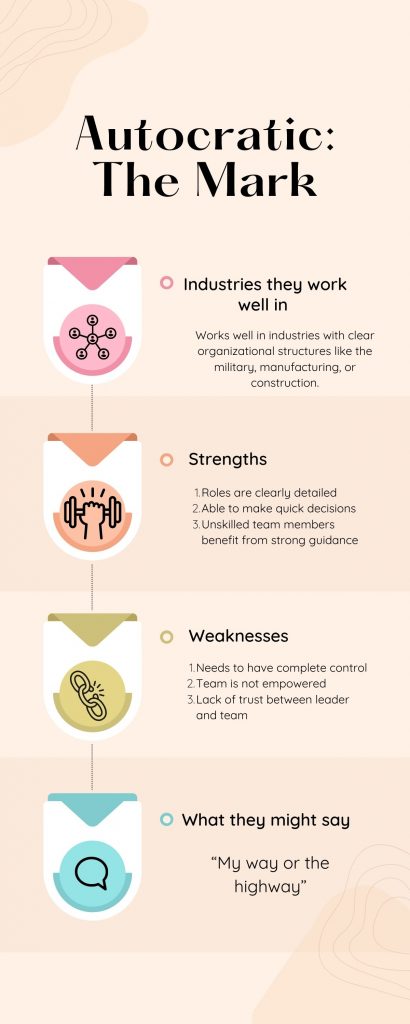
The Autocratic Leader – Mark
There is a time and a place for The Autocratic Leadership style but in a normal office environment, it is difficult to build team morale. In emergencies, this style is quite effective as it involves someone taking charge and making assertive decisions. Unfortunately, leaders who employ this method of leadership do not regularly seek input from others but because they focus primarily on goals, they tend to achieve them faster than other leaders.
My experience with The Autocratic style was frustrating and exhausting. Mark and I constantly butted heads. He regularly shot down my ideas for improvement and very rarely gave any feedback to my ideas. An example of a hill he was willing to die defending was when I suggested that our company remove 40-year-old wooden ladders from the warehouse to better utilize the floor space to store items that were regularly used. He ‘explained’ -read: yelled- at me in front of the entire company that under no circumstances could I move these ladders, despite the fact that it would improve the use of space in the warehouse and benefit the team. After this interaction, my morale had decreased dramatically, and I felt as though my enthusiasm and creativity had been destroyed. Mark’s impact on the team resulted in everyone trying to go home early rather than offering each other help. According to (What Are the Most Common Approaches to Leadership in I-O Psychology?, n.d.) this type of manager does not inspire initiative and it is clear to see this to be true given Mark’s reaction to my suggestion of improvement. In Savannah’s experience with this leadership style, she says that, “They can help when there’s and immediate decision to be made,” but she notes that even in cases where immediate decisions need to be made most people will still opt for the Pacesetting leadership style. This style, if in place over a long period of time, may have a significant impact on the morale of a team and may be particularly harmful in roles that require collaboration.
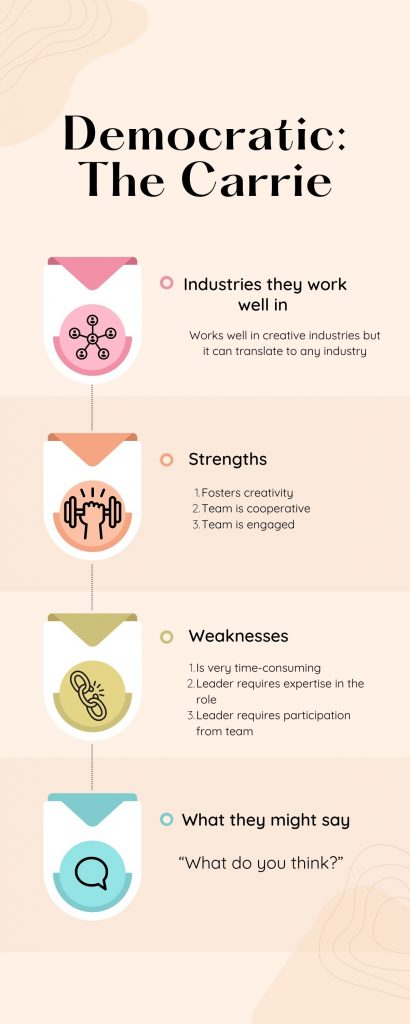
The Democratic Leader – Carrie
Arguably one of the better management styles, The Democratic Leader tries to emphasize collaboration from their team. Goals are reached as a team and actively fosters innovation and initiative. Many aspects of this style are in direct contrast to the Mark style and although they may be slower at reaching goals than the Mark style the whole team feels as if they actively contributed to their success. The boss that best exemplified this style was Carrie.
Carrie was one of my favourite bosses. During one of our projects, she called my colleague and me into her office to discuss an upcoming inventory audit. She noted that the previous team had made several mistakes and it was her goal to complete the audit as quickly and correctly as possible. We came up with a few ideas on how to achieve this goal and she delegated tasks based on our strengths. Once the audit had been completed Carrie congratulated us for achieving the goals as there had been a drastic decrease in inventory loss. Ionela (2019) states that this style is strong in its ability to lay a foundation for a committed and efficient team. There was a marked difference in my morale and productivity between my time working for Mark and my time working for Carrie. Carrie made us feel like we were a team that could rely on one another, and we strived to achieve all the same goals. Savannah believes that this style is highly effective if the organization has the time to collaborate on decisions. The Democratic style is a fantastic tool “for creative problem solving, team morale, and budling processes…”, and Savannah notes that The Democratic style proves highly effective in cases where there is organizational restructuring. She does note, however, that the Democrat’s team could be “trampled over” by a Pacesetter’s team in instances where there may be interdepartmental collaboration.
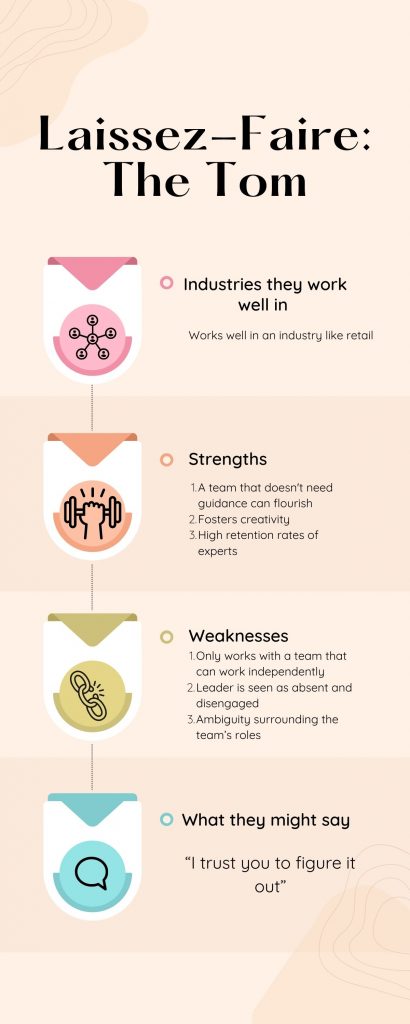
The Laissez-Faire Leader – Tom
This style should not be construed as a lazy or negative style. These leaders emphasize their confidence in the team’s ability to complete tasks without a lot of supervision. This style can only be successful with a team that knows what they are doing. If the team does not have the skills to complete a task, then everything falls apart. This style of leadership enforces accountability and discipline the least, instead of trusting individuals to do so. This type of leader also tends to be the least organized of the six most common leadership styles.
Tom exemplified this style but luckily, he had a wonderful team that was perfectly capable of executing tasks effectively. An instance of such success was in the merchandising of his stores. He owned a store with two locations about an hour apart. Every two weeks a new shipment arrived to restock the store and because Tom did not possess the power of teleportation, he had to rely on the staff to receive, unpack, and merchandise the shipments at the location where he was not present. Very rarely did he have any feedback or make any changes to our impeccable merchandising skills. He trusted and relied on his team to do a great job but wasn’t great at providing guidance and wouldn’t often hold people accountable for their mistakes. This was both a blessing and a curse as it fell to us to call out our colleagues when things weren’t up to scratch, which evidently negatively impacted some relationships within the team. Robert & Vandenberghe (2021) found that a team may actually view this leadership style as detrimental if they don’t view their leader as helping them towards the desired goal, the ramifications of which, reduce their morale and commitment. Savannah notes that this style may not improve the team’s morale, but they place a lot of trust into their team. In her experience, this style is “…most effective with highly self-sufficient individuals and experts…”. The Laissez-Faire works well in these environments because some experts may feel stifled by the other leadership styles and are more efficient when they are left to their own devices. In some cases, a team member my step into a leadership role as a secondary leader as a way of filling in on any missing qualities that may be required to help the team function effectively. Unfortunately, this style of leadership is highly ineffective in cases where there is any kind of team conflict. Savannah points out that if there is a bully or freeloader on the team the Laissez-Faire leader still expects the team to sort it out amongst themselves.
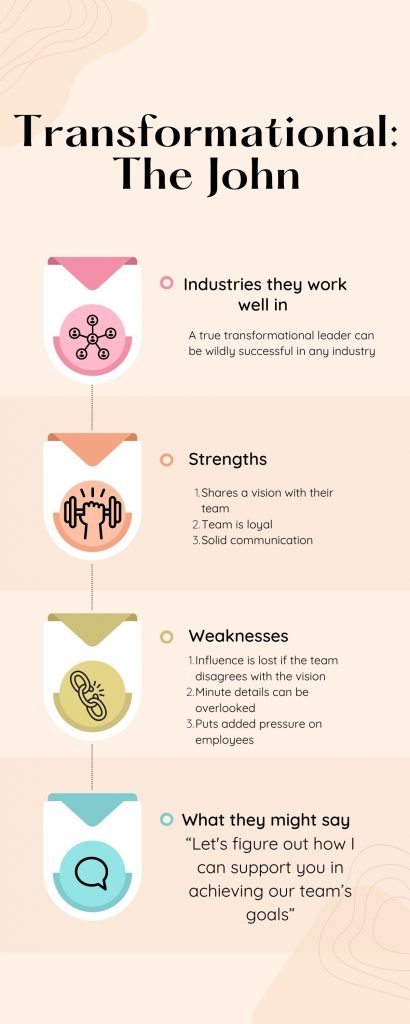
The Transformational Leader – John
The transformational style is one of the more dynamic and arguably the most effective leadership style. These leaders focus on building a relationship with team members as a way of fostering connections and camaraderie. Transformational leaders tend to see higher long-term retention rates and a healthy work environment. A common problem that this style of leadership faces is burnout. Due to the high emotional load that these leaders bear, exhaustion is common in The John style. These leaders also tend to put a lot of focus on the big picture goals and the day-to-day operations get neglected (What Are the Most Common Approaches to Leadership in I-O Psychology?, n.d.).
John was easily one of my favourite bosses. He took the time to sit down one-on-one with each member of the team to get to know them on a personal level. He explained that getting to know each of us in this way allowed him to tailor his communication style to each member of the team to avoid using the one-size-fits-all model. This wasn’t just lip service either – he actually remembered the things we told him and would ask us about some of the things we had shared with him. In my case, he would inquire about how certain classes were going for me. It made me feel heard and like he genuinely cared about my well-being, both in the workplace and outside of it. The compassion and approachability he displayed made the entire team want to improve and we made a concerted effort to achieve the goals and expectations he had set out for us. Research conducted by Villalaba (2021) found that organizations, where the managers employ a transformational leadership style, find that their teams show a strong commitment to the organization and seek to continue their employment in that organization. As effective as these leaders are at building relationships and inspiring their teams, they tend to be less focused on the day-to-day workings of the organization. Savannah notes that this kind of leader is the “…popular favourite, but they can lose the rosy hue if they’re too out of touch with the reality of their employees’ workloads and have their head in the clouds.” Even if these leaders may sometimes overlook the nitty gritty of the day-to-day operations they are firmly focused on the future and with teams comprised of self-sufficient workers this leader is incredibly effective.

The Coaching Leader – Robert
The coaching leader is fairly similar to the transformational leader, but the key difference is in the frequency of feedback provided by the coaching style. Coaching leaders are constantly giving feedback to their team on what is or isn’t working and it is done in a very positive way. Feedback is looked at as room for improvement rather than deficits in skills or knowledge Much like The John style of leadership, The Robert suffers from burnout for many of the same reasons. They take on such a heavy emotional burden that the onset of burnout is rapid. Robert was my other favourite boss. At the start of each shift, I’d have a quick meeting with Robert, and he would go over the things that he thought I had done well the previous shift and, if necessary, address anything that he wanted me to change or improve. This style of leadership worked well as there were only two employees at the time, so he had the time to sit down with us. Both my colleague and I developed a close relationship with Robert and with his support, we were able to increase the fulfilment of online orders by over 73%. The increase in productivity and efficiency allowed us, under Robert’s guidance, to focus on other areas of the organization that needed improvement. Being able to meet the goals set out for us had a positive effect on the whole team and we noticed a reduction in Robert’s stress as well as a boost in morale. As a result, the work environment became fun and playful which was incredible for team morale. Peng et. al, (2019) identified the coaching style of leadership as establishing a positive connection between the objective and subjective career successes of their underlings. In environments built by the Coaching style Savannah explained that there is a foundation of “trust, there’s respect, and there’s a healthy level of psychological safety that really benefits employees, teams, and organizations as a whole.” Due to the strength of this foundation and the team feels confident that the Coaching leader has their best interests in mind, particularly if there are any organizational changes or disruptions that may occur.
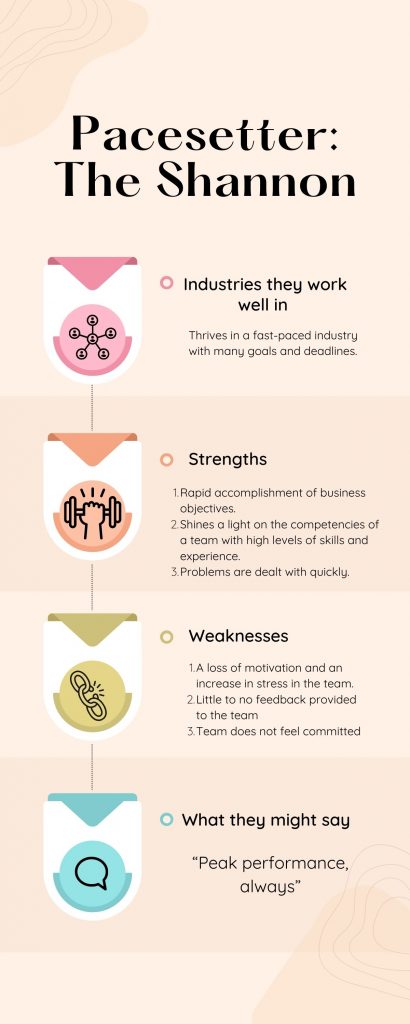
The Pacesetting Leader – Shannon
As the name may suggest, the Pacesetter style has a laser focus on achieving goals rapidly. This style loves performance and holds their team, and themselves, to a high standard. There are some instances where this style thrives. This occurs with a team that feeds off the high dynamism and only needs a general direction in which to focus their efforts. The Pacesetter is great at goal setting and holding their team accountable, often holding the “shoot for the moon, land among the stars” mentality. However, if the team has the drive and motivation but requires more direction this style can be a spectacular failure. Due to the high energy of the Pacesetter, there is little time for feedback and advice for their team which leads the team to feel overstressed and underappreciated. These feelings cause a drop in performance which clashes with the Pacesetter’s values and leads to a misalignment in goals and expectations between leader and team.
Shannon was the Director of Human Resources. She wore many hats and seemed to have her finger on the pulse of every department in the organization. I had been promoted to a role where I worked directly under Shannon, and I had many ideas that I wanted to implement. She helped me set goals that would bring my ideas to fruition but once that had been done, she offered little to no feedback on my progress. Shannon almost seemed frantic in her work ethic, she was always heading to a meeting or on the phone, which made her seem unapproachable for feedback. Goleman (2017) found that in some cases transformational leaders will transition to a Pacesetter leadership style to achieve goals in a timely manner when their original approach isn’t working. Transitioning between leadership styles isn’t uncommon for The Pacesetting leader if they are efficient. Their default may be the pacesetter style, but they can adapt their approach to get the best out of their team. The Pacesetter puts “the rest of us to shame when it comes to KPIs but, like a star, when they burnout it’s fast and you don’t want to be in the blast radius” says Savannah. Due to the high level of performance these leaders strive to maintain, the constant pressure to succeed is immense and at some point, or another they may snap. Their drive and dedication tend to shield their team from some of the pressure that they may experience from their higher-ups, but their teams can only succeed if everyone is on board for the grind. Both the Pacesetter and their teams need to be weary of burnout as the high level of performance is only sustainable for so long.
Clearly, or maybe not, there isn’t really a ‘best style of leadership’ as each style may work well in different organizations and with different teams. According to Saxena et al. (2017), the autocratic style of leadership is seen as the least effective style of leadership in most organizations, but it is often the most common style for inexperienced leaders. These researchers found that the coaching style is most prevalent among mid-level management who oversee cross-functional teams which shows their maturation to understanding that in order to get the most out of people they need to feel supported and heard by their superiors. At the senior management level, we see a further progression to a combination of transformational and democratic styles of leadership. Presumably, these leaders have quite a few years of experience and have had the time to hone their leadership skills. This is likely due to the increased level of responsibility and leading not only a small team but probably a whole organization.
It takes a lot of introspection to understand what one’s leadership style might be but figuring it out early on will give you the opportunity to improve your communication, inspire others, and lead the way for a new generation of leaders. Being a leader or a manager may not be for everyone and that’s okay. When I consider the question of “How do you like to be managed?” a combination of Transformational, Coaching, and Democratic leadership styles comes to mind. These are the styles that allow me to thrive and have given me the motivation to, when the time comes, model my leadership after these leaders. Hopefully, this article gives you insight into spotting people you want to work for and being able to decide whether a work environment will be right for you. There is no right answer for which leadership style is best, each has its own merits and can lead to success, but it depends on the environment. I’d like to offer a great quote from a professor of mine.
“ A manager does things right; a leader does the right things” – Dr Justin Wilson.
Works Cited
Frontline Leader Project. (n.d.). Retrieved April 6, 2022, from https://www.ddiworld.com/research/frontline-leader-project
House, R. J. (1971). A Path Goal Theory of Leader Effectiveness. Administrative Science Quarterly, 16(3), 321–339. https://doi-org.ezproxy.capilanou.ca/10.2307/2391905
Robert, V., & Vandenberghe, C. (2021). Laissez-faire leadership and affective commitment: The roles of leader-member exchange and subordinate relational self-concept. Journal of Business and Psychology, 36(4), 533–551. https://doi-org.ezproxy.capilanou.ca/10.1007/s10869-020-09700-9
Peng, Z., Gao, B., & Zhao, H. (2019). Coaching leadership and subordinates’ career success: The
mediating role of leader–member exchange. Social Behavior and Personality: An International Journal, 47(11), 1–8. https://doi-org.ezproxy.capilanou.ca/10.2224/sbp.8406
Villalba, J. A., Jr. (2021). The importance and impact of educational leadership: A study of the relationship between campus principals’ transformational leadership style and teachers’ organizational commitment [ProQuest Information & Learning]. In Dissertation Abstracts International Section A: Humanities and Social Sciences (Vol. 82, Issue 6–A).
What are the Most Common Approaches to Leadership in I-O Psychology? -. (n.d.). Retrieved April 6, 2022, from https://www.organizationalpsychologydegrees.com/faq/what-are-the-three-approaches-to-leadership-in-i-o-psychology/
What Is Laissez-Faire Leadership? (n.d.). Western Governors University. Retrieved April 6, 2022, from https://www.wgu.edu/blog/what-laissez-faire-leadership2006.html
